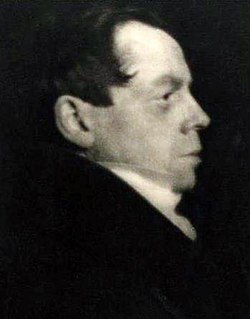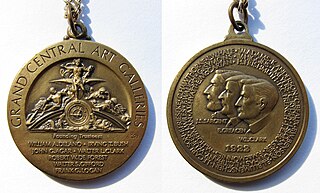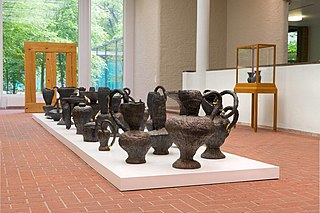Related Research Articles

Sir William Newzam Prior Nicholson was a British painter of still-life, landscape and portraits. He also worked as a printmaker in techniques including woodcut, wood-engraving and lithography, as an illustrator, as an author of children's books and as a designer for the theatre.
The New York School was an informal group of American poets, painters, dancers, and musicians active in the 1950s and 1960s in New York City. They often drew inspiration from surrealism and the contemporary avant-garde art movements, in particular action painting, abstract expressionism, jazz, improvisational theater, experimental music, and the interaction of friends in the New York City art world's vanguard circle.

Henry Ossawa Tanner was an American artist and the first African-American painter to gain international acclaim. Tanner moved to Paris, France, in 1891 to study at the Académie Julian and gained acclaim in French artistic circles. His painting Daniel in the Lions' Den was accepted into the 1896 Salon, the official art exhibition of the Académie des Beaux-Arts in Paris. Tanner's Resurrection of Lazarus was purchased by the French government after winning the third-place medal at the 1897 Salon. In 1923, the French government elected Tanner chevalier of the Legion of Honor.

The New York Biltmore Hotel was a luxury hotel in New York City that opened in 1913. It was one of three palatial hotels built as part of the Terminal City development around Grand Central Terminal in Midtown Manhattan. The others were the Commodore Hotel, and the Roosevelt Hotel. The building was gutted by developers in 1981, with predominantly its steel frame remaining. The current building has been known as Bank of America Plaza, and more recently as 335 Madison.

Hovsep Pushman was an American artist of Armenian background. He was known for his contemplative still lifes and sensitive portraits of women, often in exotic dress. He was most closely associated during his lifetime with the Grand Central Art Galleries, which represented him from its opening in 1922 until his death in 1966.

Shaped canvases are paintings that depart from the normal flat, rectangular configuration. Canvases may be shaped by altering their outline, while retaining their flatness. An ancient, traditional example is the tondo, a painting on a round panel or canvas: Raphael, as well as some other Renaissance painters, sometimes chose this format for madonna paintings. Alternatively, canvases may be altered by losing their flatness and assuming a three-dimensional surface. Or, they can do both. That is, they can assume shapes other than rectangles, and also have surface features that are three-dimensional. Arguably, changing the surface configuration of the painting transforms it into a sculpture. But shaped canvases are generally considered paintings.

Rafał Olbinski is a Polish illustrator, painter, and educator, living in the United States. He is considered one of the major representatives of the Polish School of Posters.

Hale Aspacio Woodruff was an American artist known for his murals, paintings, and prints.
Edmund William Greacen (1876–1949) was an American Impressionist painter. His active career extended from 1905 to 1935, during which he created many colorful works in oil on canvas and board. One of his works, a reproduction of which is at the Smithsonian Institution, was awarded the Salmagundi Club's Samuel T. Shaw Prize in 1922. In addition to his work as an artist, Greacen also founded, ran and taught in New York City's Grand Central School of Art for more than 20 years.
Vasudeo S. Gaitonde (1924–2001) was regarded as one of India's foremost abstract painters. He received the Padma Shri Award in 1971.

Theodore Nikolai Lukits was a Romanian American portrait and landscape painter. His initial fame came from his portraits of glamorous actresses of the silent film era, but since his death, his Asian-inspired works, figures drawn from Hispanic California and pastel landscapes have received greater attention.
Paul Gordon Georges was an American painter. He painted large-scale figurative allegories and numerous self-portraits.
Dines Carlsen was an American Expressionist painter. He was a student at, and later a member of, the National Academy of Design. He also exhibited frequently at the Pennsylvania Academy of Fine Arts. He was known particularly for his still life paintings, and in his memory his wife established the Emil and Dines Carlsen Award to recognize the Academy's best still life painter annually.

Leopold Gould Seyffert was an American artist. Born in California, Missouri and raised as a child in Colorado and then Pittsburgh, his career brought him eventually to New York City, via Philadelphia and Chicago. In New York the dealer Macbeth established him as one of the leading portraitists of the 20th century and his over 500 portraits continue to decorate the galleries, rooms and halls of many of America's museums and institutions.

The Grand Central Art Galleries were the exhibition and administrative space of the nonprofit Painters and Sculptors Gallery Association, an artists' cooperative established in 1922 by Walter Leighton Clark together with John Singer Sargent, Edmund Greacen, and others. Artists closely associated with the Grand Central Art Galleries included Hovsep Pushman, George de Forest Brush, and especially Sargent, whose posthumous show took place there in 1928.
Edward Clark was an American abstract expressionist painter and one of the early experimenters with shaped canvas in the 1950s.

Pushman v. New York Graphic Society, 287 N.Y. 302 (1942), was a case decided by the New York Court of Appeals that held that, while the copyright in a work of authorship is distinct from the tangible embodiment of the work, if the only tangible embodiment of the work is transferred the copyright is also presumptively transferred.
Robert Philipp was an American painter influenced by Impressionism and Post-Impressionism, and known for his nudes, still lifes, and portraits of attractive women and Hollywood stars. Noted art critic Henry McBride called Philipp one of America's top six painters of his generation. He was an instructor of painting at the Art Students League of New York for 33 years, the American artist Itshak Holtz was a student of Philipp. Philipp was Secretary of the National Academy of Design, and National Academician, Benjamin Franklin Fellow, Royal Society of Arts in London. He was married to model and fellow artist Rochelle ("Shelly") Post, who frequently posed for him until her death in 1971. His compositions and painting style have been compared to the art of Edgar Degas and Pierre-Auguste Renoir. Philipp won prizes in most of the important exhibitions of his time, and his paintings are in numerous museums and important private collections.

Andrew Lord is an English artist based in New York, primarily known for ceramics and drawings. In a 2010 monograph on the occasion of his exhibition at the Milton Keynes Gallery, Dawn Adès commented that his sculpture, informed by painting, ceramics poetry, the natural world and the city, exemplifies, "The centrality of material things to memory, experience, associations."
The American pavilion is a national pavilion of the Venice Biennale. It houses the United States' official representation during the Biennale.
References
- 1 2 3 "Erwin S. Barrie Dies at 97; Led Grand Central Galleries," The New York Times , July 27, 1983
- ↑ "New Home for Art to Cost $100,000," The New York Times, March 11, 1923
- ↑ "New Art Gallery Opens to Throng," The New York Times, March 22, 1923
- ↑ Roberts, Colette. "Colette Roberts papers and interviews with artists" . Retrieved March 6, 2017– via siris-archives.si.edu Library Catalog.
- ↑ "Grand Central Moderns Records: An inventory of its records at Syracuse University" . Retrieved March 6, 2017.
- ↑ "Colette Roberts – Jewish Women's Archive" . Retrieved March 6, 2017.
- ↑ "In Two Current New York Shows," The New York Times, September 17, 1950
- ↑ http://www.jamescoxgallery.com/Edge%20of%20Change/pages/Hovsep%20Pushman.htm [ dead link ]
- ↑ Henry Ossawa Tanner: American Artist, page 213
- 1 2 "Art: Golfscapes," Time magazine, November 27, 1950
- ↑ "The Talk of the Town: Impressionist," The New Yorker, September 23, 1950
- ↑ "Shopping at Grand Central Terminal". Archived from the original on January 17, 2010. Retrieved March 6, 2017.
- ↑ "Galleries to End 36 Years in Depot," The New York Times, October 31, 1958